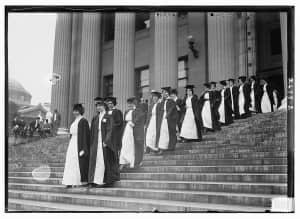Of MOOCs and Luddites: teaching and the limits of technology
By Kristopher A. Nelson
in
July 2013
800 words / 4 min.
Tweet
Share
It seems like everyone is talking about MOOCs. According to proponents, massive open online courses will revolutionize higher education and turn traditional academics into the hand weavers (and potential Luddites) of the twenty-first century. But can the efficient delivery of talking heads to far larger audiences than permitted by even the largest lecture halls, all without the geographical constraints of physical buildings, really replace today’s in-person classrooms?

Please note that this post is from 2013. Evaluate with care and in light of later events.
It seems like everyone is talking about MOOCs. According to proponents, massive open online courses will revolutionize higher education and turn traditional academics into the hand weavers (and potential Luddites) of the twenty-first century.
But can the efficient delivery of talking heads to far larger audiences than permitted by even the largest lecture halls, all without the geographical constraints of physical buildings, really replace today’s in-person classrooms?
MOOC advocates argue that traditional university education emphasizes “sage on the stage” information delivery followed by superficial assessments, all delivered at high costs to students. Thomas Friedman explains this perspective by writing that
we have to get beyond the current system of information and delivery — the professorial “sage on the stage” and students taking notes, followed by a superficial assessment.
What Friedman describes as the “current system” of university education is, in effect, exactly what MOOCs provide. Online students watch videos of lectures — perhaps broken down into “manageable chunks” — then complete multiple choice exams. Some courses supplement this with peer discussion and peer evaluation — but no one has yet figured out how to scale expert-led discussion and expert evaluation to 1,000+ students. In short, MOOCs today work best for the same classes that 200-person lecture halls serve: those defined by information delivery and regurgitation.
For some kinds of classes this system is a perfect replacement; for many others, it’s a second-class substitute for a classroom. Thus, delivering an introductory chemistry course, which typically emphasizes details, facts, and rote memorization, works just as well when via video on the Internet. In fact, since MOOCs can focus on only the best lecturers, these online versions will often be better. Testing becomes primarily a technical challenge of validating identity, since mass marking 100 multiple-choice exams is not much different for a computer than grading 10,000. If supplemented by Q&A and peer assistance — replacing teaching assistants who may or may not themselves be effective teachers — even personal help may be delivered better by MOOC than by human.
And, of course, MOOCs also compete effectively with other forms of self-learning: documentaries, public television, how-to books, and so on. In fact, the kind of learning MOOCs today permit might — I venture to say — even revolutionize many kinds of “autodidactive” learning. After all, why limit access to the best lecturers MIT or LSE can offer only to the economically and geographically privileged?
But MOOCs fail to revolutionize — well, fail to improve — other kinds of traditional university classes: those that teach critical thinking, analysis, and writing. Sure, many traditional classes do use what Paulo Freire, in 1968, called banking education:
Instead of communicating, the teacher issues communiques and makes deposits which the students patiently receive, memorize, and repeat. This is the “banking” concept of education, in which the scope of action allowed to students extends only as far as receiving, filing, and storing the deposits.
This is, in fact, the educational approach MOOC advocates criticize — and then go to deliver even more efficiently via the Internet.
 But it isn’t the core of a good liberal-arts education (which has little to do with “liberals” or “conservatives” and everything to do with producing thinking, active, knowledgable citizens). That requires teacher-student engagement, discussion, personal interactions, careful writing, including responses and editing, arguing, talking, listening. It’s what law professors mean when they say law school’s primary goal isn’t to teach the law, but rather to teach students to “think like lawyers.” (And this explains the oft-criticized Socratic method pioneered by Harvard in the late nineteenth century.) Current MOOCs simply don’t come close to delivering this kind of education.
But it isn’t the core of a good liberal-arts education (which has little to do with “liberals” or “conservatives” and everything to do with producing thinking, active, knowledgable citizens). That requires teacher-student engagement, discussion, personal interactions, careful writing, including responses and editing, arguing, talking, listening. It’s what law professors mean when they say law school’s primary goal isn’t to teach the law, but rather to teach students to “think like lawyers.” (And this explains the oft-criticized Socratic method pioneered by Harvard in the late nineteenth century.) Current MOOCs simply don’t come close to delivering this kind of education.
Still, critical thinking without data at its best is mere sophistry, and information delivery — done efficiently via MOOC — is important to a full education. And MOOCs certainly do this at least as well as traditional methods; in fact, I think they often do it better, for less money, and for more people. But they don’t effectively replace what in-person teaching, in any field (but not for every kind of material), can do today.
I like MOOCs. I like the promise of education for all. But I don’t pretend teh shiny Interwebz tech can fix all the problems of education. If any country wants to compete globally — or even just produce good citizens — they might just need, as a society, to support students and universities with more than trendy technologies.